Industrial Production Operation in the First Two Months of 2018
In the first two months of 2018, the total value added of the industrial enterprises above designated size was up by 7.2 percent year-on-year in real terms (the following growth rates of value added are real growth rates, after deducting price factors, similarly hereinafter), an increase of 1.0 percentage point from December 2017. In the first two months, the total value added of the industrial enterprises above designated size went up by 0.57 percent month-on-month.
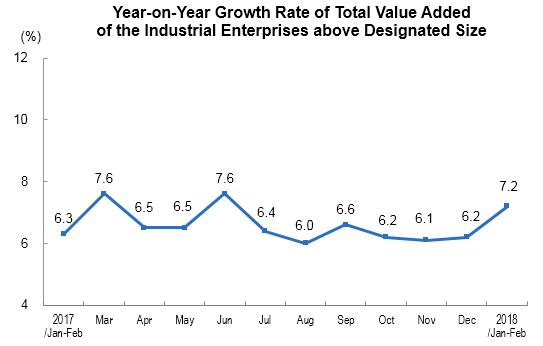
In view of three sectors, the value added of mining and quarrying increased 1.6 percent in the first two months, that of manufacturing increased 7.0 percent, and that of production and distribution of electricity, heating power, gas and water was up by 13.3 percent, year-on-year.
Analysis on different types of enterprises showed that, in the first two months, the value added of the state holding enterprises increased 9.0 percent, year-on-year, that of collective enterprises decreased 2.3 percent, that of joint-stock enterprises increased 7.3 percent, that of enterprises funded by foreign investors or investors from Hong Kong, Macao and Taiwan province increased 5.9 percent.
Grouped by different sectors, in the first two months, 37 industries within 41 industrial divisions kept year-on-year growth. Of this total, the growth of processing of food from agricultural products was 6.8 percent; the textile industry was up by 2.8 percent; the manufacture of raw chemical materials and chemical products, up by 2.4 percent; the manufacture of non-metallic mineral products, up by 4.2 percent; the manufacture and processing of ferrous metals, up by 1.7 percent; the manufacture and processing of non-ferrous metals, up by 4.4 percent; the manufacture of general-purpose machinery, up by 9.1 percent; the manufacture of special-purpose machinery, up by 10.3 percent; the manufacture of automobile industry, up by 4.9 percent; the manufacture of railway locomotives, building of ships and boats, manufacture of air and spacecrafts and other transportation equipments, up by 4.9 percent; the manufacture of electric machinery and equipment, up by 9.4 percent; the manufacture of computer, communication equipment and other electronic equipment, up by 12.1 percent; the production and supply of electric power and heat power, up by 13.1 percent.
In terms of different regions, in the first two months, the value-added of eastern region increased 6.9 percent year-on-year; central region went up by 8.2 percent; western region rose by 8.4 percent; northeastern region went up by 4.7 percent.
In terms of different products, 384 products within 596 products kept year-on-year growth. Of this total, the output of pig iron was 159.03 million tons, went up by 4.6 percent year-on-year; that of cement was 222.56 million tons, up by 4.1 percent; that of 10 kinds of nonferrous metals was 8.86 million tons, up by 1.9 percent; that of ethylene was 2810 thousand tons, down by 1.5 percent; that of automobiles was 4418 thousand sets, down by 5.0 percent; that of cars was 1788 thousand sets, down by 5.8 percent; that of electricity was 1,045.5 billion kilowatt-hours, up by 11.0 percent; that of crude oil was 93.40 million tons, up by 7.3 percent.
The sales ratio of industrial products in the first two months was 97.9 percent, remained unchanged from the same period of last year. The total export delivery value of industrial enterprises was 1,704.0 billion yuan, a nominal year-on-year increase of 9.5 percent.
| Industrial Production Operation in the First Two Months of 2018
| ||
| Indicators | Jan-Feb | |
| Absolute Value | Increase rate Y/Y (%) | |
|
|
|
|
| Value-added of Industry Above Designated Size | … | 7.2 |
| Grouped by Three Sectors |
|
|
| Mining and Quarrying | … | 1.6 |
| Manufacturing | … | 7.0 |
| Production and Distribution of Electricity, Heating Power, Gas and Water | … | 13.3 |
| Grouped by Status of Registration |
|
|
| State-holding Enterprises | … | 9.0 |
| Collective-Owned Enterprises | … | -2.3 |
| Joint-Stock Enterprises | … | 7.3 |
| Enterprises with Funds from Hong Kong, Macao and Taiwan, and Foreign Funded Enterprises | … | 5.9 |
| The Value-Added of the Main Industrial Sectors |
|
|
| Processing of Food from Agricultural Products | … | 6.8 |
| Manufacture of Foods | … | 7.3 |
| Manufacture of Textile | … | 2.8 |
| Manufacture of Chemical Raw Material and Chemical Products | … | 2.4 |
| Manufacture of Medicines | … | 12.3 |
| Manufacture of Rubber and Plastics Products | … | 3.6 |
| Manufacture of Nonmetal Mineral Products | … | 4.2 |
| Manufacture of Ferrous Metal Smelting and Pressing | … | 1.7 |
| Manufacture and Processing of Non-Ferrous Metals | … | 4.4 |
| Manufacture of Fabricated Metal Products | … | 5.5 |
| Manufacture of General Machinery | … | 9.1 |
| Manufacture of Special-Purpose Machinery | … | 10.3 |
| Manufacture of Motor Vehicles | … | 4.9 |
| Manufacture of Railways, Shipbuilding, Aerospace and Other Transportation Equipment | … | 4.9 |
| Manufacture of Electric Machinery and Equipment | … | 9.4 |
| Manufacture of Computer, Communication Equipment and Other Electronic Equipment | … | 12.1 |
| Production and Supply of Electric Power and Heat Power | … | 13.1 |
| Output of Major Products |
|
|
| Cloth (100 million meters) | 88 | 6.7 |
| Sulfuric Acid(100%) (10,000 tons) | 1378 | 2.1 |
| Caustic Soda(100%) (10,000 tons) | 574 | 4.7 |
| Ethylene (10,000 tons) | 281 | -1.5 |
| Chemical Fiber (10,000 tons) | 716 | 3.2 |
| Cement (10,000 tons) | 22256 | 4.1 |
| Plate Glass (10 000 weight boxes) | 12972 | -1.0 |
| Pig Iron (10,000 tons) | 11331 | -1.7 |
| Crude Steel (10,000 tons) | 13682 | 5.9 |
| Steel Products (10,000 tons) | 15903 | 4.6 |
| 10 Kinds Of Nonferrous Metals (10,000 tons) | 886 | 1.9 |
| Of which: Primary Aluminium (Electrolytic Aluminium) (10,000 tons) | 533 | -1.8 |
| Metal-Cutting Machine Tool (10,000 sets) | 9 | 6.1 |
| Industrial Robot (unit/set) | 18770 | 25.1 |
| Automobile (10,000 sets) | 441.8 | -5.0 |
| Of which: Saloon cars (10,000 sets) | 178.8 | -5.8 |
| SUV(10,000 sets) | 158.0 | -1.6 |
| Of which: New Energy Automobile (10,000 sets) | 8.9 | 178.1 |
| Generator Set (Power Generating Equipment) (10,000 kWh) | 1287 | -6.3 |
| Micro Computer Equipment (10,000 sets) | 3681 | -0.1 |
| Mobile Phone (10,000 sets) | 26332 | -0.1 |
| Of which: Smartphone (10,000 sets) | 19436 | -3.4 |
| Integrated Circuit (100 000 000 pcs) | 267 | 33.3 |
| Raw Coal (10,000 tons) | 51628 | 5.7 |
| Coke (10,000 tons) | 6731 | -2.7 |
| Crude Oil (10,000 tons) | 3037 | -1.9 |
| Crude Processing Volume (10,000 tons) | 9340 | 7.3 |
| Natural Gas (100 million Cubic Meters) | 262 | 4.9 |
| Electricity (100 million kWh) | 10455 | 11.0 |
| Thermal Power | 8087 | 9.8 |
| Hydro-electric Power | 1275 | 5.9 |
| Nuclear Power | 393 | 17.9 |
| Wind Power | 568 | 34.7 |
| Solar Power | 131 | 36.0 |
| Sales Ratio (%) | 97.9 | 0 |
| Export Delivery Value (100 million yuan) | 17040 | 9.5 |
|
|
|
|
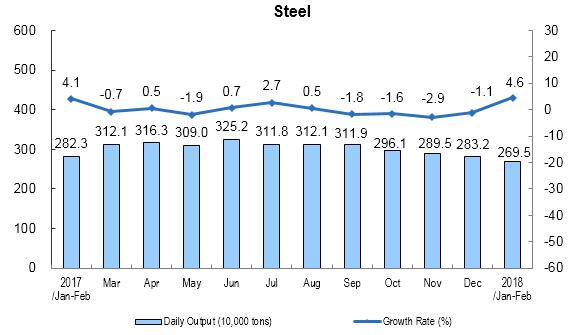
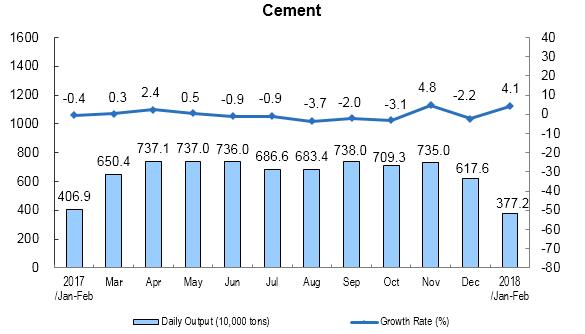
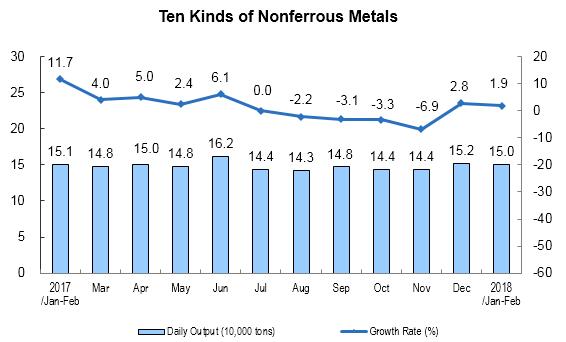
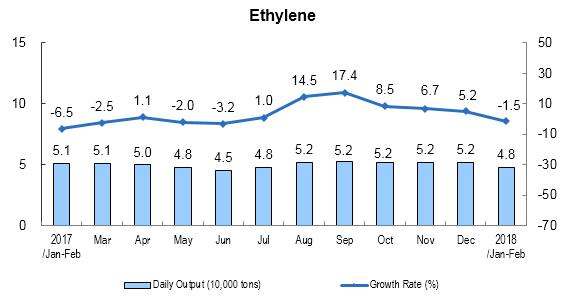

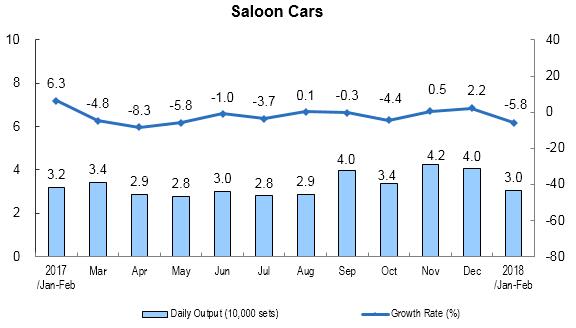
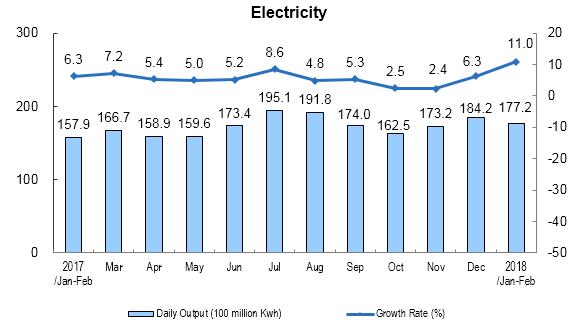
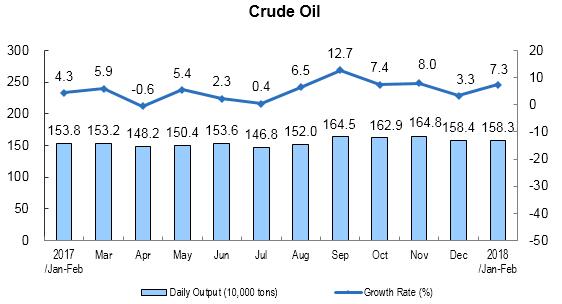
Annotations:
1. Explanation of Indicator.
Growth rate of value added of the industrial enterprises: also known as industrial growth rate, which is used to reflect a certain period of increase or decrease in volume of industrial production indicators of the degree of change. The indicator can be used to estimate the short-term trend of the industrial economy, to judge the extent of the economic boom, and also to be an important reference and basis for the formulation and adjustment of economic policies, and for the implementation of macroeconomic adjustment and control.
Sales ratio: refers to sale value and industrial output value, which reflecting the situation between production and sales of industrial products.
Export delivery value: refers to the foreign trade department of industrial enterprises or self-run (commission) exports (including sold in Hong Kong, Macao and Taiwan), with the price of foreign exchange settlement of product value, and foreign samples, materials processing, component assembly and compensation trade product value.
Daily product output: the total production of the total value added of the industrial enterprises above designated size in the current month divided by number of days in the month.
The year-on-year growth rate of product output: as industrial enterprises above designated size range will be some changes each year, according to the regulations of NBS, the data in the same period of previous year were required when enterprises submit monthly data. Hence, the year-on-year growth rate of product output was calculated by the current total value added of the industrial enterprises above designated size divided by the data submitted at the same time period.
2. Statistical Coverage.
The standard starting point of industrial enterprises above designated size was 20 million yuan of annual revenue from primary business.
3. Data Collection.
The reports of industrial enterprises above designated size are conducted with complete survey on a monthly basis (Not report for January).
4. Division on Eastern, Central and Western Regions.
Eastern region includes Beijing, Tianjin, Hebei, Liaoning, Shanghai, Jiangsu, Zhejiang, Fujian, Shandong, Guangdong, and Hainan. Central region includes Shanxi, Jilin, Heilongjiang, Anhui, Jiangxi, Henan, Hubei, and Hunan. Western region includes Inner Mongolia, Guangxi, Chongqing, Sichuan, Guizhou, Yunnan, Tibet, Shaanxi, Gansu, Qinghai, Ningxia, and Xinjiang. Northeastern region includes Liaoning, Jilin and Heilongjiang.
5. Standard on industrial classification
NBS enforces New Standard on Industrial Classification for National Economic Activities" (GB/T 4754-2017). For details, please refer the following link: http://www.stats.gov.cn/tjsj/tjbz/hyflbz.
6. Revision on month-on-month data
The month-on-month growth rate of the total value added of the industrial enterprises above designated size from February 2017 to December 2017 was revised according to the results of automatic revision of seasonal adjustment model. The results and data in the first two months of 2017 are as follows:
| The Month-on-Month Growth Rate of Industrial Production Operation
| |
| Months | Growth Rate (%) |
|
|
|
| 2017-February | 0.57 |
| March | 0.79 |
| April | 0.46 |
| May | 0.50 |
| June | 0.76 |
| July | 0.41 |
| August | 0.45 |
| September | 0.56 |
| October | 0.50 |
| November | 0.46 |
| December | 0.52 |
| 2018-January | 0.57 |
| February | 0.57 |
|
|
|
7. In order to eliminate the impact resulting from the Chinese New Year’s unfixed dates, and enhance the comparability of the data, according to national statistical system, the data of January and February over the years has been surveyed and released together.
